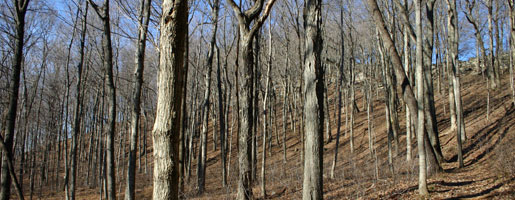
A privately run sawmill near the Forest was a destination for sawlogs. The haul road goes through the creek. The creek is used to dispose of sawdust and slabs.
By this time, most old field and harvest sites had begun to reach saw timber size. Wood output in 1949 was:
- 165,000 board feet (BF) saw timber
- 593 cords of pulpwood
- 10,228 fence posts (locust & chestnut)
- 2,000 hickory handle billets
- 2,100 mine props
- 100 tobacco barn tier poles
- 46 cords of fuel wood
Increases in harvest levels began in 1945 under a management plan revision. By 1954 annual saw timber harvest was above 200,000 BF. Before 1945 there were average annual harvest levels of around 100,000 BF of saw timber. However, salvage of dying chestnuts pushed harvest levels as high as 300,000 BF for a few years in the 1930s. The College not only sold the stumpage and logs, but also produced some lumber for construction, furniture, crafts, etc.
In 100 years, 5,000 acres of the forest has produced some 16 million board feet of saw timber. It has also turned out a tremendous quantity of other wood products. Most of that land was acquired in an old field or just harvested condition (1898-1960). Factors that have not contributed to the timber production base include:
- Land containing inoperable sites
- recreation areas
- the Owsley Fork watershed and
- tracts acquired since 1960.
The College ran its own sawmill from 1960-70. It did this after implementation of a sustained-yield management plan. That period saw an annual cut of 800,000 board feet. The complexity of the sawmill business did not fit the College well and the mill was sold. Timber production was suspended until the mid 1980s. Current annual harvest levels are in the 500,000 to 750,000 board feet range. They have both timber and wildlife management goals.
The sale of timber supports forestry operations.
